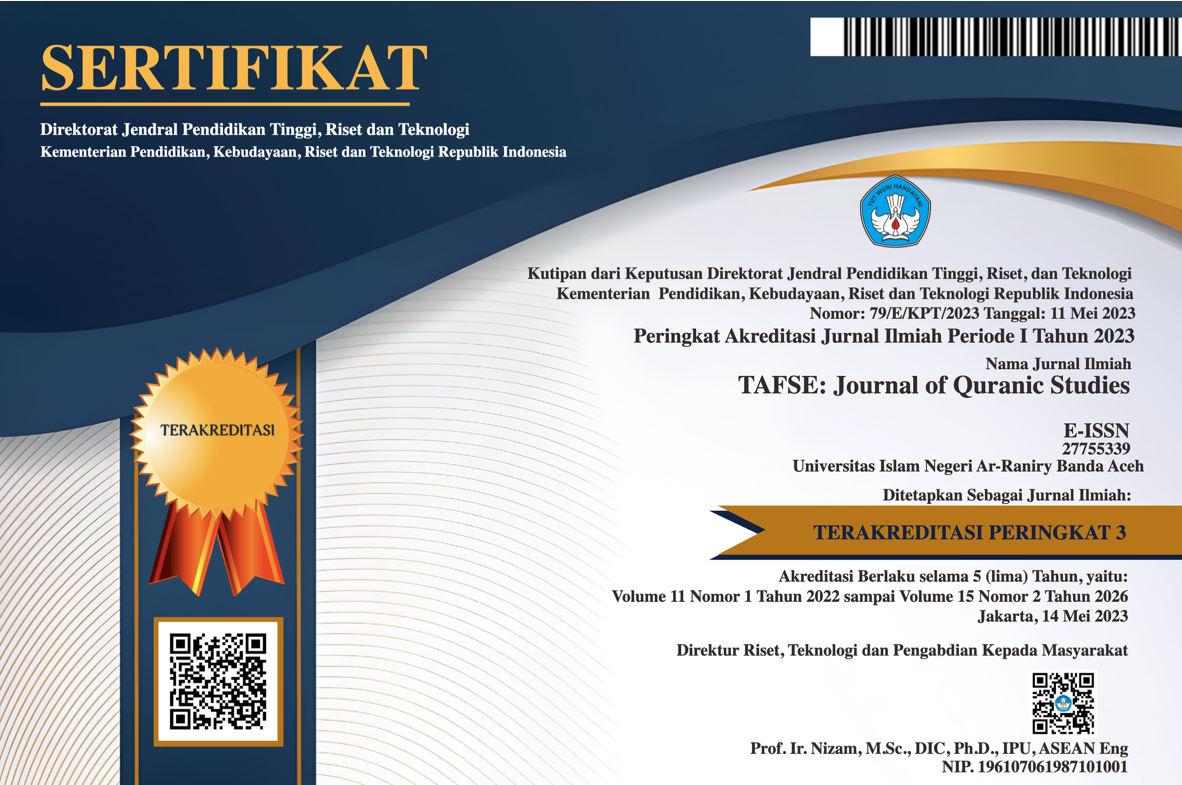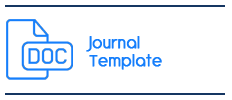Penggunaan Pajangan Ayat Kursi sebagai Pelindung
DOI:
https://doi.org/10.22373/tafse.v5i2.9103Keywords:
Ayat Kursi, Pajangan, PelindungAbstract
This article describes the living Qur’an of a Kursi verse display. On one side, many people display the Kursi verse in their effort to avoid all kinds of negative things and taking blessings. But on the other side, as far as the writer has researched from arguments of aqli and naqli, the writer hasn’t yet found an argument that can be used as evidence about a Kursi verse display can be protection for a business place from a negative thing. Based on this, the writer feels the need to do more study about this. This research is library research, with a descriptive analysis method. The data sources include the tafsir book and fiqh book with various writings related to this research. From the results of this, the writer concludes that to protect a place of business or to take blessings from the verses of the Qur’an, not by displaying or hanging up the Kursi verse, but the verses of the Qur’an will be useful and blessing if they are read, memorized, and practiced in life.
Tulisan ini mendeskripsikan pengamalan ayat al-Qur’an berupa pajangan ayat kursi. Di satu sisi, banyak masyarakat memajang ayat kursi pada dinding-dinding tempat usaha agar usahanya terhindar dari segala macam gangguan negatif dan mendatangkan berkah. Namun di sisi lain, sejauh penelusuran yang penulis teliti melalui dalil aqli dan naqli, belum ditemukan dalil yang bisa dijadikan hujjah bahwa pajangan ayat kursi bisa dijadikan pelindung dari gangguan dan pengaruh negatif. Berdasarkan hal ini, penulis merasa perlunya kajian terhadap pengamalan ayat al-Qur’an berupa pajangan ayat kursi. Tulisan ini bersifat kepustakaan, dengan metode deskriptif analisis. Sumber datanya antara lain berupa kitab tafsir dan kitab fikih serta berbagai tulisan yang berhubungan dengan penelitian ini. Berdasarkan hasil penelitian, penulis menyimpulkan bahwa untuk melindungi tempat usaha atau mengambil berkah dari ayat al-Qur’an bukan dengan memajang atau menggantungkan ayat kursi, tetapi ayat al-Quran akan bermanfaat dan mendatangkan keberkahan dengan dibaca, dihafal dan diamalkan dalam kehidupan.
Downloads
References
Al-Albani, Muhammad Nasir al-Din. Al-Silsilah Al-Shahihah, Jilid 2. Riyadh: Maktabh al-Ma’arif, n.d.
Al-Bukhari, Al-Imam Abi Abdillah Muhammad bin Ismail bin Ibrahim bin Mughirah bin Bardizbah. Shahih Al-Bukhari, Jilid 2. Libanon: Dar al-Kutub al- Ilmiah, 1992.
Al-Dimasyqi, Abu al-Fida Ismail Ibnu Kasir. Tafsir Al-Qur’an Al-‘Azhim, Jilid 3, Terj. Kampung Sunnah. Sinar Baru Algensindo, n.d.
Al-Hakim. Al-Mustadrak ’ala Al-Sahihayni, Jilid 2. Cairo: Dar al-Haramayn, 1997.
Al-Qattan, Manna’ Khalil. Mabâhis Fî ‘Ulûm Al-Qur’An. Madinah: Mansyurat al-‘Asr al-Hadist, 1973.
Al-Syaikh, Sholeh Mahmud. Ensiklopedi Fatwa Syeikh Utsaimin, n.d.
Al-Zuhaylî, Wahbah. Tafsîr Al-Munîr, Jilid 8, Terj. Abdul Hayyie Al-Kattani. Jakarta: Gema Insani, 2016.
Ash-Shiddieqy, Hasbi. Tafsir An-Nur. Semarang: Pustaka Rizki Putra, 2000.
Asy-Syafi’i, Abi Zakariya Yahya bin Syarafuddin an-Nawawi. Adab-Adab Bersama Al-Qur’an, Terj. Umniyyati Sayyidatul Hauro’, Shafura Mar’atul Zuhda, Yuliana Sahadatila. Sukoharjo: Al-Qowam, 2005.
Baqi, Muhammad Fuad Abdul. Shahih Muslim (Li Al-Imam Abi Husain Muslim Bin Al-Hujjaj Al-Qusyairi Al-Naisaburi), Jilid 1. Beirut: Dar al-Kutub al-Ilmiah, n.d.
Dkk, Dale F. Eikelman. Al-Qur’an Sains Dan Ilmu Sosial. Yogyakarta: Elsaq Press, 2010.
Falikhah, Nur. “Santet Dan Antropilogi Agama.” Al-Hadrah: Jurnal Ilmu Dakwah 11, no. 22 (2012): 130.
Fauzan, Sholeh Fauzan bin Abdillah al. Al-Sihr Wa Al-Syu’uzah. Darul Qasim, n.d.
Hanbal, Ahmad bin. Musnad Imam Ahmad Bin Hanbal. Cairo: Mu’assasah al-Risalah, 1999.
Hasan, Abdurrahman. Fathul Majid, Edisi Revisi. Pustaka Azzam, n.d.
Naparin, Husin. Memahami Kandungan Ayat Kursi. Banjarmasin: PT. Grafika Wangi, 2016.
Sani, Mukhyar. Di Bawah Naungan Al-Qur’an: Menangkap Pesan-Pesan Al-Qur’an. Banjarmasin: Antasari press Banjarmasin, 2014.
Shihab, M. Quraish. Tafsir Al-Mishbah: Pesan, Kesan, Dan Keserasian Al-Qur`an. Jakarta: Lentera Hati, 2002.
Supiyani, Muhammad. “Kualitas Hadis Keampuhan Ayat Kursi (Kritik Sanad Dan Matan).” IAIN Antasari Banjarmasin, 2008.
Downloads
Published
Issue
Section
License
Authors who publish with this journal agree to the following terms:
- Authors retain copyright and grant the journal right of first publication with the work simultaneously licensed under a Creative Commons Attribution License (CC BY NC 4.0) that allows others to share the work with an acknowledgment of the work's authorship and initial publication in this journal.
- Authors are able to enter into separate, additional contractual arrangements for the non-exclusive distribution of the journal's published version of the work (e.g., post it to an institutional repository or publish it in a book), with an acknowledgment of its initial publication in this journal.
- Authors are permitted and encouraged to post their work online (e.g., in institutional repositories or on their website) prior to and during the submission process, as it can lead to productive exchanges, as well as earlier and greater citation of published work (See The Effect of Open Access).





